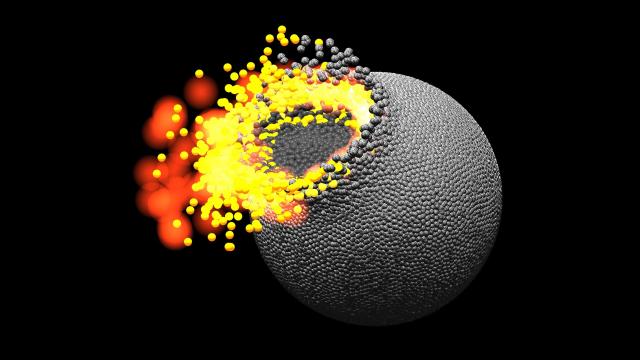The red is volatiles, the yellow is molten rock (Image: Philip J. Carter)
If you made a building out of bricks and cinderblocks, then hundreds of years later you’d expect it to still be, well, a building made of bricks and cinderblocks. But planets are not buildings if you haven’t noticed. Earth, for instance, just doesn’t seem to have the same composition as the meteors thought to have formed it. And scientists want to know how it got to be that way.
Now, two teams of researchers from Europe, Australia, and America think they have discovered more evidence supporting an explanation of how the Earth ended up so different from the stuff believed to have formed it. Their experiments, published as a pair of papers in Nature, make it clear that either the Earth or its precursors lost a whole lot of mass during the planet’s violent galactic infancy.
“The collisional history of planets causes their composition to be distinct,” study author Remco Hin from the University of Bristol told Gizmodo. “That changing composition during formation is caused by substantial vapour loss,” which Hin thought could have made up almost half of the pre-Earth mass.
Each group fills in a different part of the story. Hin and his team looked specifically at the magnesium isotopes in chondrites, meteorites that haven’t been altered since they landed here on Earth. The team noticed that the Earth has a ratio of these isotopes (which differ by the number of neutrons in their nuclei) that is unlike those found ancient meteorites, with Earth’s composition featuring more of the heavier flavours of magnesium. Then, the researchers ran a model to see if vaporisation of some specific elements with lower boiling points called volatiles could have accounted for the Earth’s present-day composition — and their model matched the data quite well.
The second paper helped explain how this might have happened. A pair of researchers melted Earth rock (as opposed to space rocks) in a specially-formulated furnace that had tight controls on the gas and watched what happened to the elemental composition. They determined we could have ended up with the amount of volatiles present on Earth through evaporation and condensation working alongside specific concentrations of surrounding gases like oxygen and hydrogen.
So when could these violent, hot evaporation events have happened? The teams conclude it was sometime during the stage when smaller proto-planets were crashing and colliding to create the larger Earth, or potentially during whatever large collision created our Moon.
Together, the papers add more detail to the story of how our Earth ended up looking the way it does. “These studies are important contributions to our current understanding of Earth’s composition both in terms of how it compares to the more primitive material (chondrite meteorites) from which it was made, and in explaining why chemical differences might exist between the two,” Catherine Macris, an assistant professor in Earth Sciences at Indiana University-Purdue University Indianapolis, told Gizmodo.
Frédéric Moynier, a cosmochemist at the University of Paris, Diderot, who reviewed both papers told Gizmodo in an email that he wants to see Hin’s group study the Moon’s magnesium next, since the Moon’s composition should either be similar to Earth’s or have even more heavy magnesium compared to the chondrites. Hin would also like to build more, better models to run over his data.
As for the other paper, Moynier felt it was important in the way it showed the oxygen concentration’s impact on the Earth’s composition. He noted that certain results of the furnace experiment seemed reliant on the amount of rock cooking time — he’d like to see further modelling because didn’t think the amount of time should have mattered in those cases. Bernard Wood, a geologist from the University of Oxford and author of that paper, told Gizmodo he is now also looking into other elements left out of the initial publication to ensure they match his newest results.
Macris said that, ultimately, both studies show that scientists need to do more work to understand how melting and vaporisation of rock dictated what the planet looks like today. She said that “novel high-temperature experiments combined with precise measurements of natural materials work hand-in-hand to further our understanding of Earth’s ancient history and solve longstanding problems pursued by Earth and planetary scientists for decades.”
You’re probably wondering what all this means for life on Earth. Among other things, this research potentially raises questions about how water got here, especially if it was lost as a volatile early in Earth’s history.
But Hin said, “Whether that means anything for life I wouldn’t dare say.”
